


Dangerous Muzzleloaders: A History
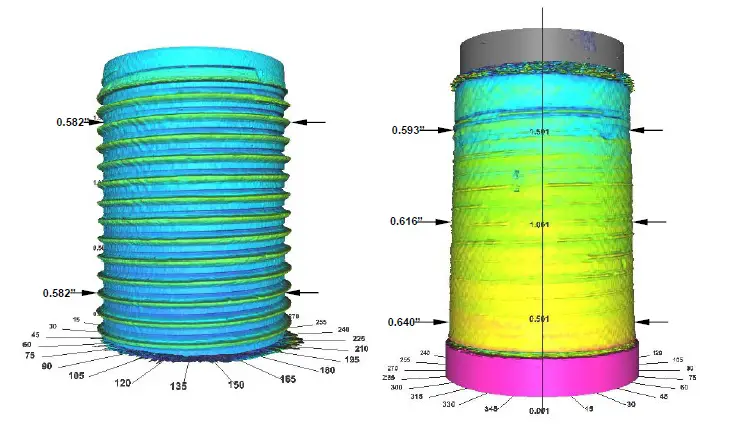
The above 3D laser surface scans show a typical set of barrel threads on the left, with the tapered or "bell-mouthed" defective CVA barrel thread attempt on the right. As a direct result of malformed and virtually non-existent barrel threads on a recent production CVA muzzleloader, Steve Tipton, Ph.D., P.E., Frank W. Murphy Distinguished Professor of Mechanical Engineering concluded that the barrel breech plug threads "were defective and dangerous" and that "The threads were insufficient to contain the breech plug upon its initial firing." Dr. William J. Bruchey also noted that "failure was due to manufacturing or design defects which resulted in poor engagement of the breech plug with improperly formed barrel threads." Yet, despite this catastrophic failure upon the first shot fired, no warnings have ever been made from the manufacturer, no recall has ever been generated.
Bob
Hickey was the CEO (or President) of Connecticut Valley Arms that
used a variety of low-end manufacturers for product, including Dikar in
Spain. CVA became a name brand, not a premium one, but nevertheless a
known brand with distribution. Bob Hickey and company (various investors,
etc.) had the bright idea that they could import guns from Dikar for
$18 (???) or so from Dikar, retail them for $99, and make a bag full of
money. Note that the euro was not born until 1999 so this was all Spanish
lira equivalents. That's what they did, in 1995 - 1996, and as this was
right in the middle of the inline muzzleloading industry growth, they
sold tons of them. 60,000 putty-barreled guns in two years, just breathtaking
sales. I don't know the exact figures, but they lined their pockets with
some $5 million dollars in a few years. But.
The "but" is the guns had problems, major league problems with
stripped breechplugs, etc., and people quickly got hurt. Lots of people
got hurt, hurt badly enough to generate a bucket-load of litigation. The
bagful of cheap, smarmy cash evaporated quickly and CVA became insolvent,
spiraling towards bankruptcy.
On the other side of the pond, Dikar had also made a nice hunk of change
popping out the el cheapo "Apollo" along with sidelocks they
were supplying at the time. Dikar is a fairly large company, though Spanish
companies don't have the type of structure that American companies are
compelled to have. Dikar is described as an "employee owned cooperative."
No way did they want to lose their very profitable American outlet for
their stuff. What to do? In an employee owned cooperative, everyone has
some vested interest in profits along the way. There is a "Voluntary
Recall" on the 1995-1996 guns, but what should puzzle everyone is
that to this day the REASON for the recall is something that CVA has been
unable to state. Sure, there are recalls in a variety of fields-- but
the reason for them is normally well-stated. Surely, there must be a reason?
A problem discovered, one that has been fixed? To read the CVA recall,
you won't find any basis for it, no reason, just that the guns are recalled.
It is puzzling and troubling to have a recall of two complete years of
firearm production with no reason stated, known, or revealed-- even now,
some fourteen years later. As far as a truly "voluntary recall,"
that is a confusing term. There are guidelines for a recall, according
to the CPSC: "Moreover, section 214 of the
CPSIA specifically provides that the Commission should "include any
information that the Commission determines would be helpful to consumers"
in order to identify the product, understand the identified hazard, and
understand the proposed remedy . . . Moreover, the CPSC has provided guidance
to firms conducting recalls to post recall notices prominently on the
home page of the firm's web site since at least 2000." These
guidelines are still not followed by CVA, B.P.I., or Dikar. The specific
hazards associated with CVA muzzleloaders are not identified, the
proposed remedy (a replacement) is far from clear, and no . . .
it is hardly prominently placed on the B.P.I. website. All it gives you
is a phone number, no address, no form, not nothing. You would think that
if B.P.I. was actually serious about the old recall they would at least
bother to have one simple web page devoted to it with all the particulars?
As
far as I know, the manufacturer, Dikar S. Coop. of Bergara, Spain, never
initated a recall. The recall of 1997 was initiated by the "old C.V.A,"
the importer. It was not until May, 1999 (according to B.P.I.)
that B.P.I acquired the assets of the old CVA, and merely continued the
importer-based recall that already existed. As in the case of any public
recall, the recalls that can be easily gotten are already done, so comparatively
few guns remain. B.P.I. states "Blackpowder Products, Inc. assumes
no liability for any products manufactured or sold prior to January 1,
1998." It is a puzzling, tortured trail of paperwork for also
right now Dikar S. Coop of Bergara, Spain, owns 100% of the stock of Blackpowder
Products, Inc., so the manufacturer is the one and the same. The "Old
CVA" had Bob Hickey and Jay Brenneman as its officials, while the
new company Blackpowder Products had Bob Hickey listed as its C.F.O. until
2006. You don't hear much about Jay Brenneman, but Jay moved on to become
CEO of Traditions Performance Firearms, another saga in itself selling
extruded barrel Spanish muzzleloaders as well, mostly made by Ardesa of
Spain.
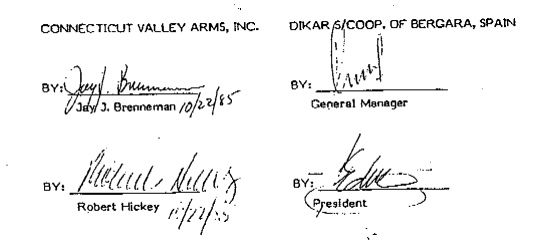
Hardly a new idea, Bergara barrels have been around for years. The Dikar Cooperative has long been in Bergara, Spain, as the dated signatures above clearly show-- and that was 1985.
Ostensibly,
the "CVA answer" was grab officespace in Georgia, fund and form
an American company "B.P.I" and rescue CVA from the throes of
its bankruptcy. They hired Bob Hickey, former CVA Prez, and found a couple
of other employees like Dudley that they picked up from general sporting
goods and clothing sales. Bingo, now the inmates not just run the asylum,
they also own it. Better yet, as no outside part gets a cut of sales.
B.P.I acquired the "assets" of CVA (not much except a brand
name), Bob Hickey CFO still had all his distribution connections and
it was off to the races.
It worked. They cobbled together cheap copies of pre-existing Knight Rifles
and Thompson rifles, copied the contents of Knight and Thompson owners
manuals (even their load info) and sold against Knight and T/C
on the basis of price. The "Winchester Apex" and ill-fated CVA
Kodiak was a copy of Thompson's wildly popular Omega. Their break action
Optima was an attempt to copy the look of the break-action Encore.
It worked as well. Now they were selling $50 (???) guns for $200 or $300
or more, and they got to keep all the proceeds. Not subject to American
labor costs, EPA, OSHA, etc., they pumped out the putty guns at a brisk
pace. The guns themselves came over in large containers and went
straight to big-box stores like Cabela's and Basspro without
having to be ever touched, much less actually examined or tested on American
soil. What happens in Spain, stays in Spain.
They made so much money that they bought Big Bore Express (maker of
Powerbelt bullets) and built a new plant for them. They sold and continue
to sell tons of these little numbers at a buck or more a bullet
with a production cost of a few cents.
Giddy with all this cash, they not only bought Powerbelt bullets, they
ratcheted-up their print and TV ads, and publish their own magazine--
"Blackpowder Guns & Hunting." It is a great deal, as now
Dikar owns their American distributor storefront, they own the bullets,
and they own their own media. Sounds like they have it all. They did and
do. But.
The "but" is, that in their zeal to profit and grow, they
forgot to learn from their own 60,000 gun salute of a recall. They forgot
to use proper materials or use proper testing. They forgot that Thompson
was a center-fire rifle company accustomed to SAAMI standards with their
own barrel line. They forgot that EBSCO, owner of Knight Rifles, used
Green Mountain barrels which they also owned, a major OEM barrel
supplier also accustomed to SAAMI standards and American industry
practices.
European CIP protocol demands proof-testing on everything, including blank
and starter pistols. It demands inspection before and after the firing
of two shots. They know all this, they are quite familiar with the CIP
"House of Eibar" proof house.
But, there is one tiny catch to industry standard proofing. The proof-testing
(as done by Pedersoli, Uberti, other European black powder rifle manufacturers
for product sold in the U.S.) has one negative-- it costs money. Regular
proof-testing ensures safe product, that's what the Rules of Proof are
all about. Considered a crime in Europe to sell without proof, it slides
neatly beneath the radar in the U.S. that has no national proof house
and is not a member of the CIP / EU.

A proof mark on a firearm is an international proclamation that the gun has been proof-fired with an overload, then inspected and passed. You'll note this has been used in advertising, as by Winchester in the above ad from 1953. The proof mark on a "CVA" muzzleloader is worse than meaningless-- it is fraudulent. CVA branded muzzleloaders sold in the U.S. are proofed 0% of the time, according to Dikar testimony. Yet, the fraudulent proof-marks have been applied nevertheless for years.
Green
Mountain Barrels controls the melt at the mill, uses certified steel along
with eddy-current testing and magnafluxing. Thompson uses certified steel
as well and has long touted their own "continuous magnafluxing"
process. It all costs money, though, and both GM and T/C reject entire
lots of steel that are not up to snuff. They have to. All of their assets
are here in the U.S. and exposed. All Green Mountain does is make barrels,
their existence depends on a quality barrel. Dikar's assets are tucked
away in Spain, with little comparative exposure or accountability in the
U.S.
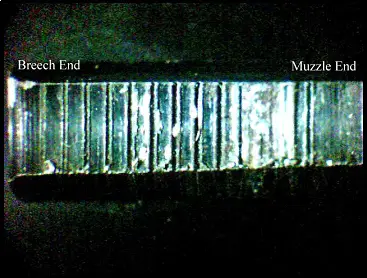
The above macro-photograph reveals the improperly formed or virtually non-existent threads in a CVA barrel. Other CVA rifles exhibited this same problem, but to a lesser degree. No warnings or recalls have been forthcoming from CVA, even though this horrible problem has been known to them for years. Reasonable quality control or proof-testing would have resulted in a failure on the bench-- this rifle never would have left the Bergara, Spain plant. Unfortunately, it was imported into the United States, went through distribution and sold at retail by an Ace Hardware. The first shot ever fired resulted in tragedy. A gun like this is a menace.
So,
Dikar has had problems ever since. Of course they KNOW it, you can't get
sued 100 times and not know it. They have done their best to replace failed
guns with new ones in the case of no major injury. Those guns are quickly
discarded and to quote CVA officials "NO RECORDS ARE KEPT."
In the event of cases that they can quickly settle (with a non-disclosure
agreement) they have-- so no one is the wiser. The guns are discarded,
quickly, "NO RECORDS KEPT." Non-disclosure agreements are commonplace:
you want the cash on the table, take it and go play shut-up . . . or take
your chances with years of expensive legal wrangling, and try to find
a law firm with $300,000 to speculate on your case and an uncertain jury
verdict. Eric Zenger was able to contact me directly and speak out, as
in his case they stuffed it up-- he signed no non-disclosure agreement.
Bob Hickey, CFO, now retired, did little more than fly around the country
and pay people off. As unbelievable as it might sound, that is what happened
some years back when I flew to Tulsa to meet with Eaton & Sparks.
They had three CVA cases going at the same time, all non-recall, and they
were all settled out of court. Jimmy Dial, Eliot Best, and Troy Cashdollar
were the three, separate incident victims.
Best vs Blackpowder
Products, Inc., et al, Oklahoma, 2003 model Mag Hunter, serial # 61-13-030412-03,
alleged new out of the box, failed the first time it was fired, barrel
exploded and split open causing serious injuries to the victims left hand,
settled before filing.
Cashdollar vs Blackpowder Products, Inc., et al, Pennsylvania, 2001 model
Eclipse, serial # 61-13-030288-01, breech plug stripped out blowing
the bolt, spring and end cap into victims face, settled before
filing.
Dial vs Blackpowder Products, Inc., et al, Oklahoma, 2001 model Eclipse,
serial # 61-13-030713-01, breech plug stripped out blowing the bolt,
spring and end cap into victims face, settled before filing.
Three at one time, NONE of them recalled, and NONE of these cases ever
filed. This, as I recall, surprised the heck out of veteran attorneys
Gary Eaton and Bill Sparks. Normally, they have to file to get somebody's
attention. B.P.I. tossed out the cash like they do it all the time. There
is a good reason for this: they do it all the time.
So, that's where we are today. B.P.I. knows there are problems with recent
production Eclipse models, they know there are problems with recent Mag
Hunter models, and they know there are problems with recent Kodiak and
Optima models. There is even a case going on with a 2008 production CVA
Wolf right now, a case I have no independent knowledge of beyond that.
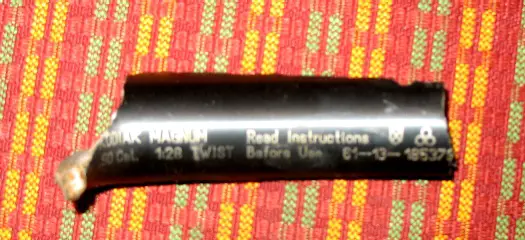
The
above photograph is part of the barrel from Mark Kohn's recent production
CVA, a photograph that I personally took. Although official proof marks
are clearly visible on the barrel, we know now they are fraudulent. No
CVA branded muzzleloaders sold in the United States are proof-tested,
according to Dikar S. Coop official's sworn testimony in open court. Zero
percent proof-testing makes catastrophic failure the first time the gun
is fired both predictable and foreseeable. Any consumer would be led to
believe that, based on these official proofmarks, the gun had indeed both
been proof-fired and had passed proofhouse examination after those proof-firings.
This was not the case here, nor is it ever the case according to
Dikar's Mr. Aitor Belategi.
No effort has ever been made to get Eclipse guns off the street. No effort has been made to get Mag Hunters off the street. No effort has been made to recover, examine, or even warn of potential KNOWN problems with Kodiaks and other models with malformed, only partially formed breechplug threads.
Could it get any worse? Well, actually it did. Thompson-Center Arms promoted “Magnum Muzzleloading” and “Anything Out to 200 Yards Is Toast.” Both Knight and Thompson promoted high-performance muzzleloaders, a non-specific term but commonly referred to a “magnum three pellet loads.” CVA / B.P.I. / Dikar was not to be outdone in the ad-brag department. Still using weaker, inferior, extruded barrel material considered as unsuitable by T/C and Knight, they started stamping “Magnum” on their guns. But. The “but” part is that it was all a lie. CVA guns were the same in magnum and non-magum versions, same steel, same animal. Even though the CVA owners manual warns the user to use three pellet loads only in “Magnum” labeled guns, it was a false, fraudulent, warning. The only difference was the cheap “Magnum” stamp on the gun, a marketing con that allowed CVA to sell the same old gun for a higher price.
That became another problem, a big problem as in the case of victim Jimmy Dial. While I was in Tulsa, Oklahoma, I spoke with Jimmy Dean Dial on speakerphone with attorney Gary A. Eaton present. It turns out that Jimmy had used his CVA Eclipse for several years, shooting extremely lightweight bullets and 120 grains of Pyrodex. I recall questioning Jimmy as to why he was using such unusually lightweight bullets. Jimmy's answer made perfect sense, “He didn't like recoil.” Alright, so it went for about three years. But then Jimmy was target shooting with a buddy that was using an Encore and "magnum" loads. Jimmy was having accuracy problems with his CVA and his buddy suggested he try his regular load, a heavier load. Unfortunately, that's exactly what Jimmy did and the result was instant, catastrophic failure on the first and only "magnum" load he ever fired and the injuries that he suffered as a result. So it goes. Note that Dikar has stated that there is no difference between a "magnum" CVA and a "regular" CVA except for the stamp that says magnum, and the more profitable selling price that goes along with it.
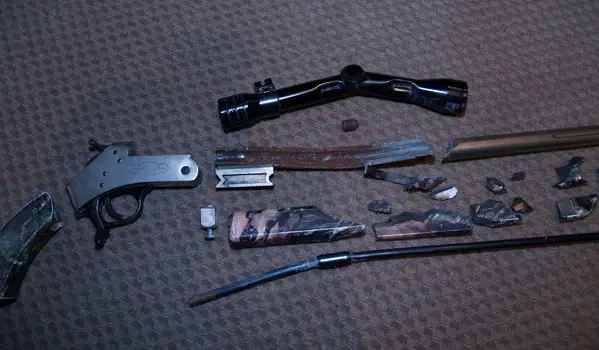
Above
is William Lawson's CVA Optima Pro that failed on January 1, 2009, causing
injuries to Mr. Lawson's hands and face. According to testimony of Mr.
Belategi of Dikar in open court, "B.P.I belongs to Dikar."
Further, Mr. Belategi confirmed that only 4% (one out of every 25 barrels)
are have their threads checked with a threaded go/no-go gauge. Though
CVA branded guns are stamped as though they are proof-tested, in actuality
they are not. Only Dikar guns sold in Europe are actually proof-tested,
but selling a few guns in Europe was a practice Dikar ended around 2001.
Guns destined for the American market bear the same proof-marks, athough
the barrels have not been proof-tested or in any way subjected to pressure.
Five barrels a month, not completed guns, are claimed as sent to the proof
house. Eventually scrapped, no records are kept. This testimony was given
December 8, 2008. Mr. Belategi agreed that "if they wanted to send
a Magnum going for sale in the United States to the proofhouse officials
to run their European proof tests on it, it would be, quote, tested
at a pressure less than it's going to be used."
And,
all this time, "NO RECORDS ARE KEPT." How many times this same
scenario has played out is unknown.
Is it too much to expect, in light of these known problems, to at least
suggest that a new CVA owner gets his barrel examined by a qualified gunsmith
to make sure there are enough threads present in the barrel to keep the
breechplug from blowing into the shooter's skull? We have issues with
1997 guns, 2001 guns, 2004 guns, 2008 guns etc., etc., a rubrik encompassing
both recent production and "Bergara" barreled guns.
Any reputable source in the industry will tell you that a breechplug failure
is an absolutely unacceptable mode of failure. It cannot happen with a
properly made muzzleloader. It cannot and does not happen with smokeless
powder in guns tested to destruction with smokeless powder. I am well
aware and completely familiar with muzzleloaders that undergo destructive
testing. Moreover, when a breechplug fails but there are no pressure signs
in the barrel, anywhere, it is cause from immediate great concern, if
not outright alarm. It is not possible without both a manufacturing defect
and gross negligence in testing-- regardless of brand of rifle. For those
that have asked for my opinion, it is now offered for your consideration.
As a professional firearms evaluator for many years, I have reviewed CVA products before. I've never declined to review a CVA-branded product, but I've not actively sought the opportunity as of late, either. The basis is simple. Although I have a very good array of equipment, threaded go/no-go gauges appropriate for CVA-Dikar-Bergara barrels are not among them. It is not reasonable to look forward to reviewing a firearm that has a 96% percent chance of not having having its barrel properly inspected and right at a 100 percent chance of not having been proof-tested, or having the barrel pressurized in any way before it arrives in my hands. Those aren't the type of odds that anyone would appreciate.
CVA is only a brand, a brand controlled by B.P.I, which in turn has long belonged to Dikar of Bergara, Spain. With 0% proof testing of their firearms and a 4% inspection rate of a critical area like a barrel's breechplug threads, it isn't possible or reasonable to suggest their use. For Jimmy Dial, Eliot Best, Troy Cashdollar, Mark Kohn, Jon Katzenmeier, their parents, wives, and children (and countless others) this editorial comes regrettably late. Dikar's own puny 4% barrel thread inspection rate has still netted sixty or so barrels in house that were defective, these barrels destroyed with apparently no records kept. It is an astonishing, if not inexplicable failure to warn the consumer. No warnings even now at this late date, no recalls, no cautionary words about getting CVA branded product inspected by a qualified gunsmith that has been shipped and sold at retail in the United States. Yet, for the last seven years or so the influx of Bergara-machined barrels into the United States has persisted without change in quality or inspection procedures, according to Dikar's Mr. Aitor Belategi. This is quite a magnificent failure to warn and failure to act to resolve known issues and easily foreseeable incidents.
Robeaux vs Blackpowder Products Inc, et al, 2003 model .50 cal New Frontier, serial number 61-13-064064-03, injured 10/03/2009, alleged failure that the barrel exploded and caused serious injuries to the shooters left hand and arm, face and vision of left eye, pending. This IS NOT a "recalled" CVA case.
Shockey vs Connecticut Valley Arms, et al, Tennessee, Shelbyville, Bedford County, TN, CVA Buckmaster, serial # 61-13-061922-95, injured 12/15/1996, settled before filing.
Slaght vs Connecticut Valley Arms, et al, State Court, Michigan, Oakland, MI, 2001 model .50 cal CVA, serial # 61-13-158677-01, injured 03/29/2002, case filed 06/18/2004, settled, closed 01/10/2005, 6 months after filing in state court, alleged that the muzzleloader was new out of the box, failed the first time that it was fired, muzzleloader exploded and parts were blown into victims face. This IS NOT a "recalled" CVA case.
J. Smith vs Dikar S. Coop, Ltd, et al, Federal Court, Louisiana, Eastern District, LA, 1994 model CVA (side lock), serial # 956439, injured 01/09/2009, alleged failure that the muzzleloader fired without the set trigger or firing trigger having been pulled, shooting the victim in the hand, filed 07/09/2009, pending. This IS NOT a "recalled" CVA case.
Underwood vs Connecticut Valley Arms, et al, State Court, Ohio, Guernsey County, OH, 2004 model .45 cal CVA Kodiak, serial number 61-13-104092-04, injured 12/26/2007, case filed 12/17/2009, alleged failure that the muzzleloader exploded and caused the loss of the shooters right eye and severe injuries to his face, settled September 2010. This IS NOT a "recalled" CVA case.
Just last month, January 2014, I was contacted by over one dozen individuals or law firms regarding catastrophic failures of "CVA" and "Traditions" branded Spanish muzzleloaders (actually made by Dikar or Ardesa). It has been the same every year, year after year.
Safety
first, always, and then have a great hunt is a good way to go.
So, here's hoping everyone has some great hunts in store for them.
Pure opinion by Randy Wakeman
Copyright 2010, 2014 by Randy Wakeman. All Rights Reserved.
This opinion may not be copied, transmitted, displayed, performed, distributed, rented, licensed, sub-licensed, altered, stored for subsequent use, framed, or otherwise used in whole or in part in any manner without Randy Wakeman's prior written consent. You may not frame this site or link to any page in this site without the prior written consent of Randy Wakeman.

Custom Search


